The Teagasc sheep stakeholder group, which includes farmers and industry representatives, met last Friday in Mellows Campus Athenry. One of a number of research updates delivered was a visit to the Irish and New Zealand Across Country (INZAC) genetic flock.
The trial, which is comparing the performance of elite Irish and New Zealand genetics, is coming to the end of the second production cycle.
While the flocks present in Athenry will continue to be the main driver of production data collected, Teagasc geneticist Noirin McHugh says the focus in 2018 and beyond is expanding the range of information collected and also seeing how the elite Irish and New Zealand genetics perform in commercial flocks.
“We have collected a large volume of data in the first two years, but we now want to focus on and pinpoint differences in key performance areas. One aspect is focusing more on the ewe side and looking at factors such as ewe intake,” she said.
“The data collected so far has shown us that the New Zealand ewes are more vigorous grazers, but we want to see just how much more they are eating and if this extra intake is driving higher lamb performance, which looks to be the case.”
Commercial scenario
A second longer-term component of the trial is assessing how ewes perform in a crossbred commercial scenario.
“Ultimately, we want to identify genetics that will perform best for commercial farmers in grass-based production systems.
“To accurately do this, we have linked up with a number of the Teagasc BETTER farm sheep flocks who have expressed an interest in retaining female replacements.
“Rams have been used in four flocks this year and have been single-sire mated with a group of ewes that will allow about 15 daughters to be retained from each sire used. We will follow these progeny through and measure traits such as their maternal ability, health, ewe survival and lamb performance,” said Noirin.
The target is to grow the number of commercial flocks using Irish and New Zealand genetics to 10 for the 2018 breeding season.
In 2018 we want more direct carcase data
Along with collecting ewe data, this avenue will increase the volume of slaughter data collected, which to date has been limited by a focus on retaining a high percentage of male-born progeny for breeding.
Noirin said: “The aim first and foremost has been to develop a source of rams that can be used for breeding. We have carried out carcase scanning in 2016 and 2017 and used this information to predict carcase characteristics, but in 2018 we want more direct carcase data.
“Building a flock of breeding rams over the last two years will allow us to slaughter a high percentage of male progeny in the coming year. Carcase data from commercial flocks will provide another source of information and increase the accuracy of genetic evaluations.”
GHG emissions
According to Noirin, another interesting component of the trial in 2018 is determining methane emissions. PAC chambers, which are essentially special glass boxes, are being imported from New Zealand and will allow emissions to be collected on all sheep in a relatively easy set-up.
Sheep will spend about 40 minutes in the apparatus and an added bonus of the venture is that it will provide an indicator of ewe and lamb intake.
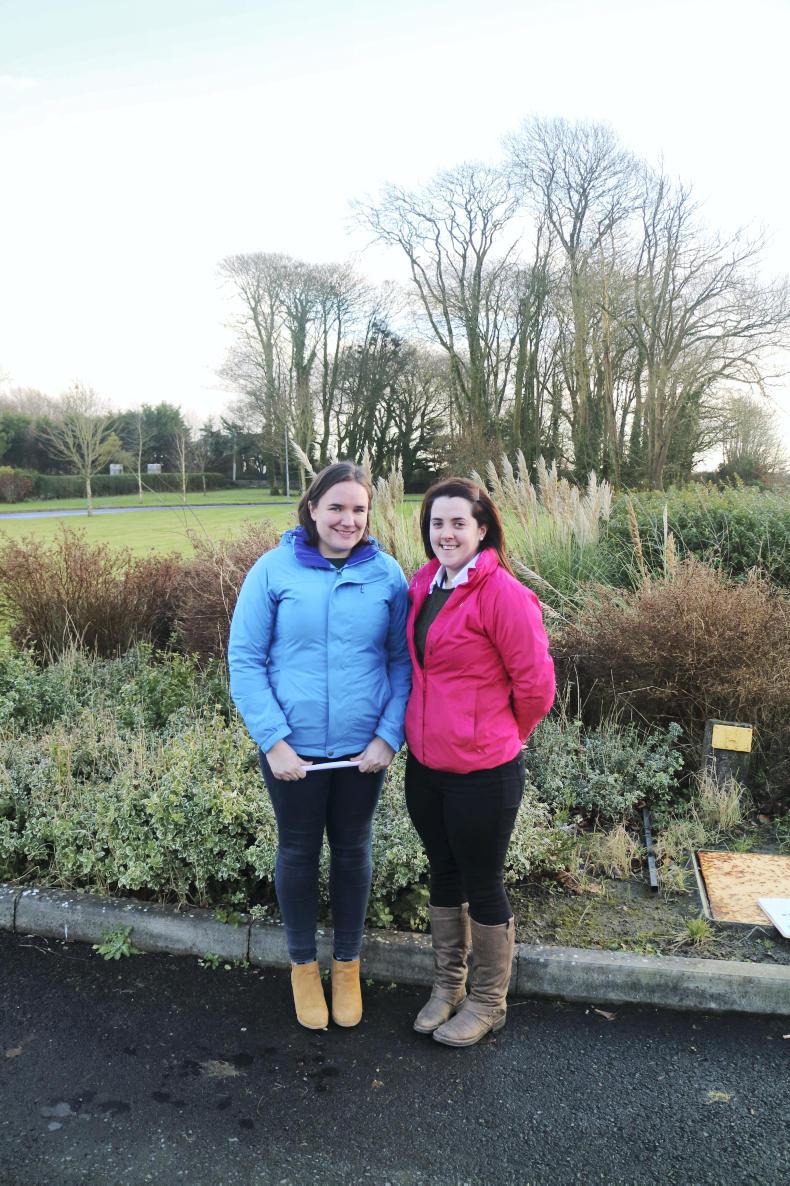 Commenting on what it is expected to deliver, Noirin (pictured, left) said: “There is a lot of talk recently about emissions from agriculture and the industry needs to be in a position to accurately determine the actual volume of methane produced.
Commenting on what it is expected to deliver, Noirin (pictured, left) said: “There is a lot of talk recently about emissions from agriculture and the industry needs to be in a position to accurately determine the actual volume of methane produced.
“Previous work in this area has shown that there will definitely be differences in the level of methane produced by different animals, but it will be interesting to see if there are differences between ewes as per their treatment groups.”
Results update
As mentioned above, there is now two years’ production data collected on the pedigree flocks.
Flock researcher Fiona McGovern (pictured, right) explains that New Zealand ewes and their progeny continue to outperform the elite Irish genetics, which in turn are outperforming the low genetic merit (LGM) Irish group. Table 1 details reproductive performance and lambing performance to date.
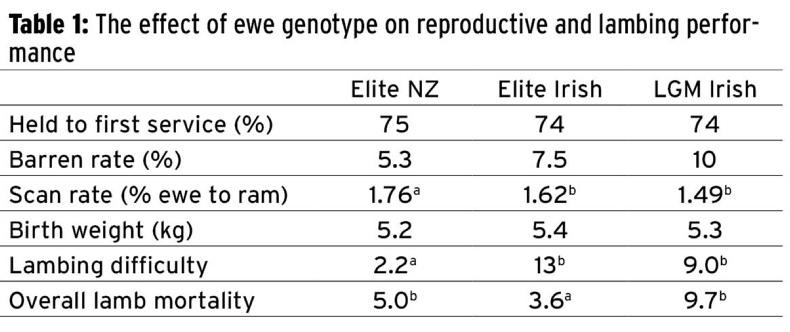
Fiona said: “The New Zealand ewes have positioned themselves as the top performers after the first two years. They have achieved a significantly higher scanning rate, but it should be noted that this is being influenced by the New Zealand Texels being more prolific due to the direction of their breeding programme and the incorporation of prolific genes into the breeding mix.
“They have outperformed both groups of Irish ewes in terms of a lower barren rate and greater lambing ease. The elite Irish ewes recorded greater lambing difficulty, but once lambs were born they were very vigorous and up quick to suckle. This contributed to the low mortality rate of 3.6%.”
This trend was also evident in lamb performance, as can be seen in Table 2. As expected, this influenced the days to slaughter figure and drafting rate for lambs. This is detailed in Figure 1 and Figure 2, with 96% of the New Zealand born lambs drafted off grass alone, 82% of the elite Irish progeny and 69% of the LGM Irish group.
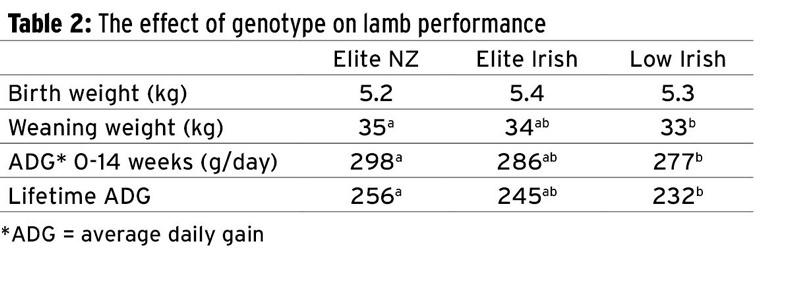
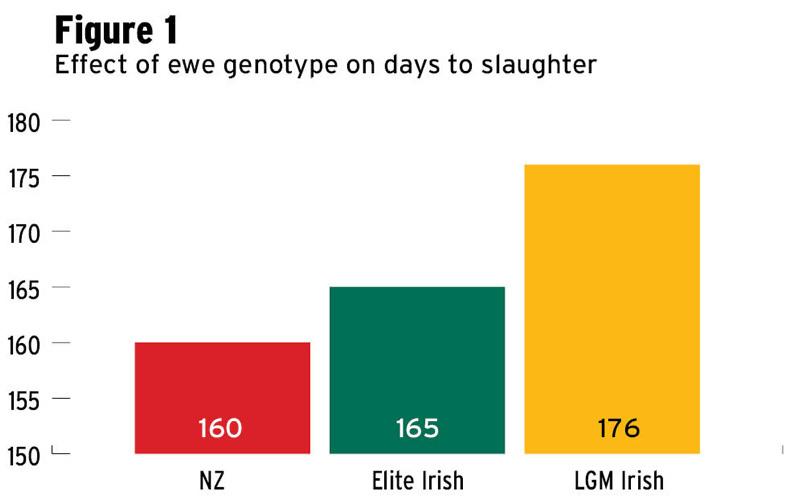
While lambs were not slaughtered, they were drafted out of their grazing groups once they hit a defined liveweight, which commenced at 42kg in June and increased 1kg per month thereafter. This was done with the aim of delivering a carcase weight of 19kg to 20kg.
Current management
All ewes are now housed for about two weeks. This is slightly earlier than the target, but Fiona explains that there was a higher stocking rate on the farmlets for a few weeks after artificial insemination to cater for spare ewes being bred to ensure group size remains at 60 ewes.
This resulted in grass reserves being depleted about a week to 10 days before target.
Ewes have been housed on a diet of good-quality ad-lib silage and were shorn last week. Along with boosting lamb birthweight, shearing has been carried out to make better use of available housing space and allow easier monitoring of body condition score.
There is no real difference in weight across the three groups, but the New Zealand ewes look to be in the best condition.
“We have found that the New Zealand ewes can maintain their body condition better. There is no significant difference in weight between these and the Irish ewes, but the New Zealand ewes have a smaller head and lower bone density, which adds weight to the high and low genetic merit Irish ewes.”
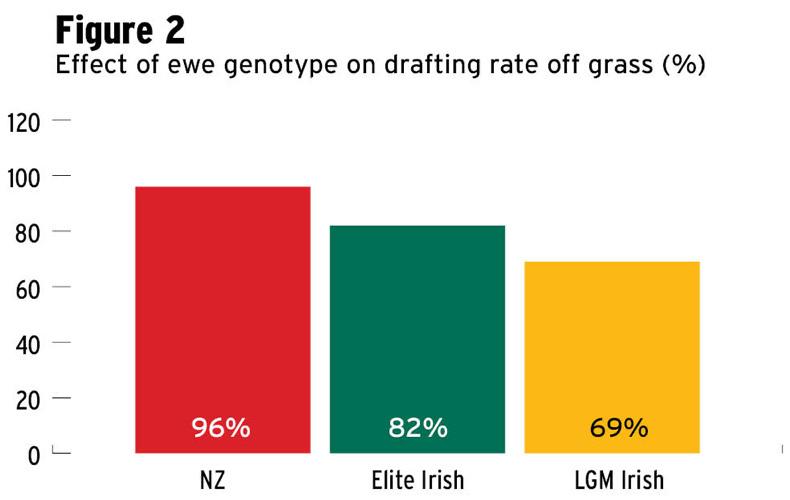
Trial recap
The INZAC trial in Athenry consists of 180 ewes, with Suffolk and Texel genetics selected, as they are the most common breeds across the two countries.
The ewes are split into three sub-flocks – a flock of 60 New Zealand Suffolk and Texel ewes with elite genetics, 60 Irish Suffolk and Texel ewes with elite genetics (rated as five-star on the €uro-Star index) and 60 Irish low genetic-merit (rated as one-star on the €uro-Star index) Suffolk and Texel ewes.
Each group is run as a separate farmlet at a stocking rate of 12 ewes per hectare, with lambs drafted out of the trial once they reach target drafting weights.
While the elite groups will allow for benchmarking genetics across countries, it will also serve as an important tool to validate the Sheep Ireland replacement index. This is the main reasoning behind the incorporation of a low-index group into the trial.
Information will be collected on the flocks plus, in 2018, information will be collected from the commercial flocks which have used INZAC flock sires for breeding.
Read more
Potential to finish light hill lambs
The Teagasc sheep stakeholder group, which includes farmers and industry representatives, met last Friday in Mellows Campus Athenry. One of a number of research updates delivered was a visit to the Irish and New Zealand Across Country (INZAC) genetic flock.
The trial, which is comparing the performance of elite Irish and New Zealand genetics, is coming to the end of the second production cycle.
While the flocks present in Athenry will continue to be the main driver of production data collected, Teagasc geneticist Noirin McHugh says the focus in 2018 and beyond is expanding the range of information collected and also seeing how the elite Irish and New Zealand genetics perform in commercial flocks.
“We have collected a large volume of data in the first two years, but we now want to focus on and pinpoint differences in key performance areas. One aspect is focusing more on the ewe side and looking at factors such as ewe intake,” she said.
“The data collected so far has shown us that the New Zealand ewes are more vigorous grazers, but we want to see just how much more they are eating and if this extra intake is driving higher lamb performance, which looks to be the case.”
Commercial scenario
A second longer-term component of the trial is assessing how ewes perform in a crossbred commercial scenario.
“Ultimately, we want to identify genetics that will perform best for commercial farmers in grass-based production systems.
“To accurately do this, we have linked up with a number of the Teagasc BETTER farm sheep flocks who have expressed an interest in retaining female replacements.
“Rams have been used in four flocks this year and have been single-sire mated with a group of ewes that will allow about 15 daughters to be retained from each sire used. We will follow these progeny through and measure traits such as their maternal ability, health, ewe survival and lamb performance,” said Noirin.
The target is to grow the number of commercial flocks using Irish and New Zealand genetics to 10 for the 2018 breeding season.
In 2018 we want more direct carcase data
Along with collecting ewe data, this avenue will increase the volume of slaughter data collected, which to date has been limited by a focus on retaining a high percentage of male-born progeny for breeding.
Noirin said: “The aim first and foremost has been to develop a source of rams that can be used for breeding. We have carried out carcase scanning in 2016 and 2017 and used this information to predict carcase characteristics, but in 2018 we want more direct carcase data.
“Building a flock of breeding rams over the last two years will allow us to slaughter a high percentage of male progeny in the coming year. Carcase data from commercial flocks will provide another source of information and increase the accuracy of genetic evaluations.”
GHG emissions
According to Noirin, another interesting component of the trial in 2018 is determining methane emissions. PAC chambers, which are essentially special glass boxes, are being imported from New Zealand and will allow emissions to be collected on all sheep in a relatively easy set-up.
Sheep will spend about 40 minutes in the apparatus and an added bonus of the venture is that it will provide an indicator of ewe and lamb intake.
 Commenting on what it is expected to deliver, Noirin (pictured, left) said: “There is a lot of talk recently about emissions from agriculture and the industry needs to be in a position to accurately determine the actual volume of methane produced.
Commenting on what it is expected to deliver, Noirin (pictured, left) said: “There is a lot of talk recently about emissions from agriculture and the industry needs to be in a position to accurately determine the actual volume of methane produced.
“Previous work in this area has shown that there will definitely be differences in the level of methane produced by different animals, but it will be interesting to see if there are differences between ewes as per their treatment groups.”
Results update
As mentioned above, there is now two years’ production data collected on the pedigree flocks.
Flock researcher Fiona McGovern (pictured, right) explains that New Zealand ewes and their progeny continue to outperform the elite Irish genetics, which in turn are outperforming the low genetic merit (LGM) Irish group. Table 1 details reproductive performance and lambing performance to date.

Fiona said: “The New Zealand ewes have positioned themselves as the top performers after the first two years. They have achieved a significantly higher scanning rate, but it should be noted that this is being influenced by the New Zealand Texels being more prolific due to the direction of their breeding programme and the incorporation of prolific genes into the breeding mix.
“They have outperformed both groups of Irish ewes in terms of a lower barren rate and greater lambing ease. The elite Irish ewes recorded greater lambing difficulty, but once lambs were born they were very vigorous and up quick to suckle. This contributed to the low mortality rate of 3.6%.”
This trend was also evident in lamb performance, as can be seen in Table 2. As expected, this influenced the days to slaughter figure and drafting rate for lambs. This is detailed in Figure 1 and Figure 2, with 96% of the New Zealand born lambs drafted off grass alone, 82% of the elite Irish progeny and 69% of the LGM Irish group.


While lambs were not slaughtered, they were drafted out of their grazing groups once they hit a defined liveweight, which commenced at 42kg in June and increased 1kg per month thereafter. This was done with the aim of delivering a carcase weight of 19kg to 20kg.
Current management
All ewes are now housed for about two weeks. This is slightly earlier than the target, but Fiona explains that there was a higher stocking rate on the farmlets for a few weeks after artificial insemination to cater for spare ewes being bred to ensure group size remains at 60 ewes.
This resulted in grass reserves being depleted about a week to 10 days before target.
Ewes have been housed on a diet of good-quality ad-lib silage and were shorn last week. Along with boosting lamb birthweight, shearing has been carried out to make better use of available housing space and allow easier monitoring of body condition score.
There is no real difference in weight across the three groups, but the New Zealand ewes look to be in the best condition.
“We have found that the New Zealand ewes can maintain their body condition better. There is no significant difference in weight between these and the Irish ewes, but the New Zealand ewes have a smaller head and lower bone density, which adds weight to the high and low genetic merit Irish ewes.”

Trial recap
The INZAC trial in Athenry consists of 180 ewes, with Suffolk and Texel genetics selected, as they are the most common breeds across the two countries.
The ewes are split into three sub-flocks – a flock of 60 New Zealand Suffolk and Texel ewes with elite genetics, 60 Irish Suffolk and Texel ewes with elite genetics (rated as five-star on the €uro-Star index) and 60 Irish low genetic-merit (rated as one-star on the €uro-Star index) Suffolk and Texel ewes.
Each group is run as a separate farmlet at a stocking rate of 12 ewes per hectare, with lambs drafted out of the trial once they reach target drafting weights.
While the elite groups will allow for benchmarking genetics across countries, it will also serve as an important tool to validate the Sheep Ireland replacement index. This is the main reasoning behind the incorporation of a low-index group into the trial.
Information will be collected on the flocks plus, in 2018, information will be collected from the commercial flocks which have used INZAC flock sires for breeding.
Read more
Potential to finish light hill lambs
 Commenting on what it is expected to deliver, Noirin (pictured, left) said: “There is a lot of talk recently about emissions from agriculture and the industry needs to be in a position to accurately determine the actual volume of methane produced.
Commenting on what it is expected to deliver, Noirin (pictured, left) said: “There is a lot of talk recently about emissions from agriculture and the industry needs to be in a position to accurately determine the actual volume of methane produced. 




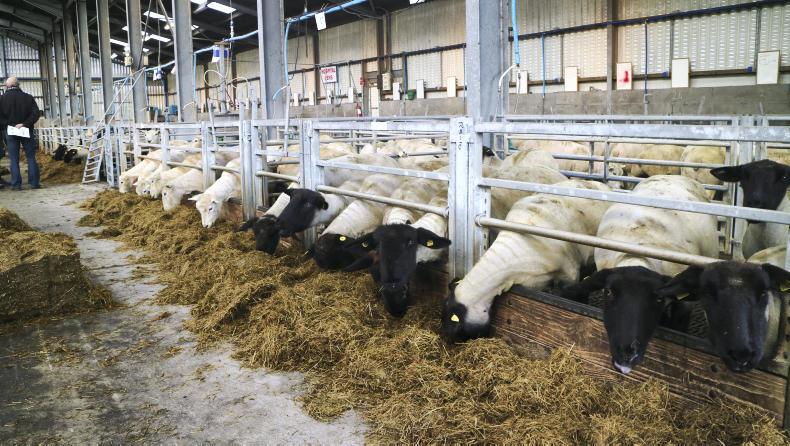




 This is a subscriber-only article
This is a subscriber-only article















SHARING OPTIONS: